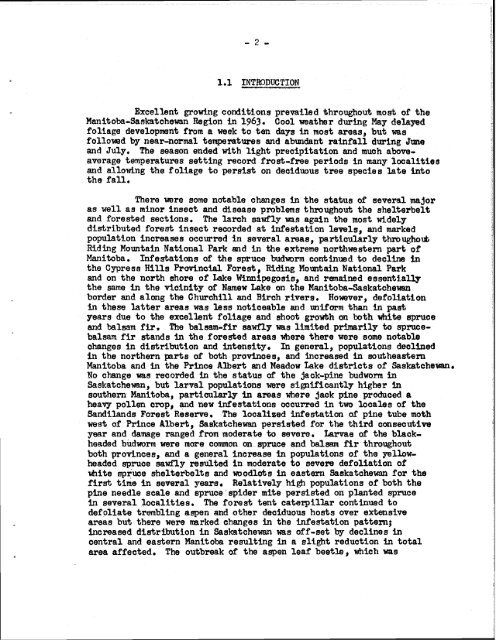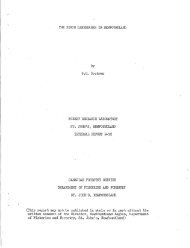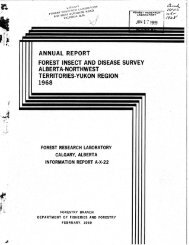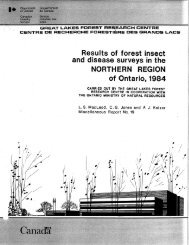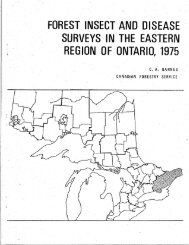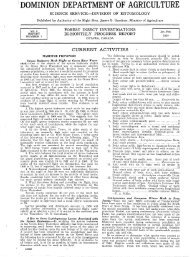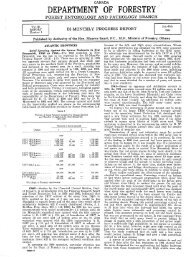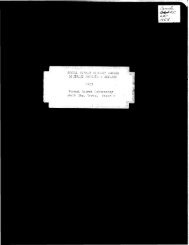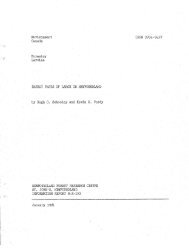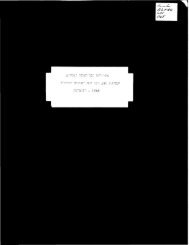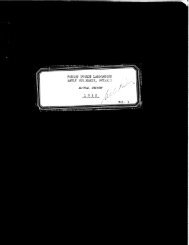Annual District Reports: Forest Insect and Disease Survey ... - NFIS
Annual District Reports: Forest Insect and Disease Survey ... - NFIS
Annual District Reports: Forest Insect and Disease Survey ... - NFIS
You also want an ePaper? Increase the reach of your titles
YUMPU automatically turns print PDFs into web optimized ePapers that Google loves.
1.1 INTRODUCTION<br />
Excellent growing conditions prevailed throughout most of the<br />
Manitoba-Saskatchewan Region in 1963. Cool weather during May delayed<br />
foliage development from a week to ten days in most areas, but was<br />
followed by near-normal temperatures <strong>and</strong> abundant rainfall during June<br />
<strong>and</strong> July. The season ended with light precipitation <strong>and</strong> much aboveaverage<br />
temperatures setting record frost-free periods in many localities<br />
<strong>and</strong> allowing the foliage to persist on deciduous tree species late into<br />
the fall.<br />
There were some notable changes in the status of several major<br />
as well as minor insect <strong>and</strong> disease problems throughout the shelterbelt<br />
<strong>and</strong> forested sections. The larch sawfly was again the most widely<br />
distributed forest insect recorded at infestation levels, <strong>and</strong> marked<br />
population increases occurred in several areas, particularly throughout<br />
Riding Mountain National Park <strong>and</strong> in the extreme northwestern part of<br />
Manitoba. Infestations of the spruce budworm continued to decline in<br />
the Cypress Hills Provincial <strong>Forest</strong>, Riding Mountain National Park<br />
<strong>and</strong> on the north shore of Lake Winnipegosis, <strong>and</strong> remained essentially<br />
the same in the vicinity of Namew Lake on the Manitoba-Saskatchewan<br />
border <strong>and</strong> along the Churchill <strong>and</strong> Birch rivers. However, defoliation<br />
in these latter areas was less noticeable <strong>and</strong> uniform than in past<br />
years due to the excellent foliage <strong>and</strong> shoot growth on both white spruce<br />
<strong>and</strong> balsam fir. The balsam-fir sawfly was limited primarily to sprucebalsam<br />
fir st<strong>and</strong>s in the forested areas where there were some notable<br />
changes in distribution <strong>and</strong> intensity. In general, populations declined<br />
in the northern parts of both provinces, <strong>and</strong> increased in southeastern<br />
Manitoba <strong>and</strong> in the Prince Albert <strong>and</strong> Meadow Lake districts of Saskatchewan.<br />
No change was recorded in the status of the jack-pine budworm in<br />
Saskatchewan, but larval populations were significantly higher in<br />
southern Manitoba, particularly in areas where jack pine produced a<br />
heavy pollen crop, <strong>and</strong> new infestations occurred in two locales of the<br />
S<strong>and</strong>il<strong>and</strong>s <strong>Forest</strong> Reserve. The localized infestation of pine tube moth<br />
west of Prince Albert, Saskatchewan persisted for the third consecutive<br />
year <strong>and</strong> damage ranged from moderate to severe. Larvae of the black<br />
headed budworm were more common on spruce <strong>and</strong> balsam fir throughout<br />
both provinces, <strong>and</strong> a general increase in populations of the yellowheaded<br />
spruce sawfly resulted in moderate to severe defoliation of<br />
white spruce shelterbelts <strong>and</strong> woodlots in eastern Saskatchewan for the<br />
first time in several years. Relatively high populations of both the<br />
pine needle scale <strong>and</strong> spruce spider mite persisted on planted spruce<br />
in several localities. The forest tent caterpillar continued to<br />
defoliate trembling aspen <strong>and</strong> other deciduous hosts over extensive<br />
areas but there were marked changes in the infestation pattern;<br />
increased distribution in Saskatchewan was off-set by declines in<br />
central <strong>and</strong> eastern Manitoba resulting in a slight reduction in total<br />
area affected. The outbreak of the aspen leaf beetle, which was


